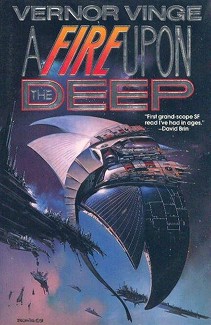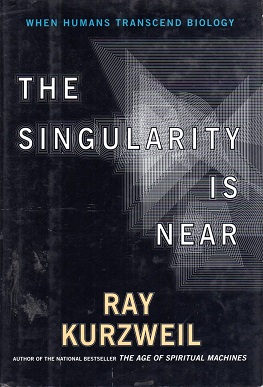
A Fire Upon the Deep is a 1992 science fiction novel by American writer Vernor Vinge. It is a space opera involving superhuman intelligences, aliens, variable physics, space battles, love, betrayal, genocide, and a communication medium resembling Usenet. A Fire Upon the Deep won the Hugo Award in 1993, sharing it with Doomsday Book by Connie Willis.

Vernor Steffen Vinge is an American science fiction author and retired professor. He taught mathematics and computer science at San Diego State University. He is the first wide-scale popularizer of the technological singularity concept and among the first authors to present a fictional "cyberspace". He has won the Hugo Award for his novels A Fire Upon the Deep (1992), A Deepness in the Sky (1999), Rainbows End (2006), and novellas Fast Times at Fairmont High (2002), and The Cookie Monster (2004).
The technological singularity—or simply the singularity—is a hypothetical future point in time at which technological growth becomes uncontrollable and irreversible, resulting in unforeseeable consequences for human civilization. According to the most popular version of the singularity hypothesis, I. J. Good's intelligence explosion model, an upgradable intelligent agent will eventually enter a "runaway reaction" of self-improvement cycles, each new and more intelligent generation appearing more and more rapidly, causing an "explosion" in intelligence and resulting in a powerful superintelligence that qualitatively far surpasses all human intelligence.

Augmented reality (AR) is an interactive experience that combines the real world and computer-generated content. The content can span multiple sensory modalities, including visual, auditory, haptic, somatosensory and olfactory. AR can be defined as a system that incorporates three basic features: a combination of real and virtual worlds, real-time interaction, and accurate 3D registration of virtual and real objects. The overlaid sensory information can be constructive, or destructive. This experience is seamlessly interwoven with the physical world such that it is perceived as an immersive aspect of the real environment. In this way, augmented reality alters one's ongoing perception of a real-world environment, whereas virtual reality completely replaces the user's real-world environment with a simulated one.

True Names is a 1981 science fiction novella by American writer Vernor Vinge, a seminal work of the cyberpunk genre. It is one of the earliest stories to present a fully fleshed-out concept of cyberspace, which would later be central to cyberpunk. The story also contains elements of transhumanism.
Orion's Arm is a multi-authored online science fiction world-building project, first established in 2000 by M. Alan Kazlev, Donna Malcolm Hirsekorn, Bernd Helfert and Anders Sandberg and further co-authored by many people since. Anyone can contribute articles, stories, artwork, or music to the website. A large mailing list exists, in which members debate aspects of the world they are creating, discussing additions, modifications, issues arising, and work to be done.

Joan D. Vinge is an American science fiction author. She is known for such works as her Hugo Award–winning novel The Snow Queen and its sequels, her series about the telepath named Cat, and her Heaven's Chronicles books. She also is the author of The Random House Book of Greek Myths (1999).

Singularitarianism is a movement defined by the belief that a technological singularity—the creation of superintelligence—will likely happen in the medium future, and that deliberate action ought to be taken to ensure that the singularity benefits humans.

A Deepness in the Sky is a science fiction novel by American writer Vernor Vinge. Published in 1999, the novel is a loose prequel to his earlier novel A Fire Upon the Deep (1992). The title is coined by one of the story's main characters in a debate, in a reference to the hibernating habits of his species and to the vastness of space.

The Singularity Is Near: When Humans Transcend Biology is a 2005 non-fiction book about artificial intelligence and the future of humanity by inventor and futurist Ray Kurzweil.

The Peace War is a science fiction novel by American writer Vernor Vinge, about authoritarianism and technological progress. It was first published as a serial in Analog in 1984, and in book form shortly afterward. It was nominated for the Hugo Award for Best Novel in 1985. A sequel, Marooned in Realtime, was published in 1986. The two novels and "The Ungoverned", a related novella, are collected in Across Realtime.

Marooned in Realtime is a 1986 murder mystery and time-travel science fiction novel by American writer Vernor Vinge, about a small, time-displaced group of people who may be the only survivors of a technological singularity or alien invasion. It is the sequel to the novel The Peace War (1984) and the novella The Ungoverned (1985). Both novels and the novella were collected in Across Realtime.
In futures studies and the history of technology, accelerating change is the observed exponential nature of the rate of technological change in recent history, which may suggest faster and more profound change in the future and may or may not be accompanied by equally profound social and cultural change.

Accelerando is a 2005 science fiction novel consisting of a series of interconnected short stories written by British author Charles Stross. As well as normal hardback and paperback editions, it was released as a free e-book under the CC BY-NC-ND license. Accelerando won the Locus Award in 2006, and was nominated for several other awards in 2005 and 2006, including the Hugo, Campbell, Clarke, and British Science Fiction Association Awards.
Marc Stiegler is an American science fiction author and software developer. He co-authored Valentina: Soul in Sapphire (1984) with Joseph H. Delaney. The novel features Valentina, a computer program that is one of science fiction's earliest examples of sentient software, in contrast to mainframe-based AIs such as HAL and Colossus. His notable works also include David's Sling (1988), a techno-thriller that explores the concept of e-democracy.

The Collected Stories of Vernor Vinge is a collection of science fiction short stories by American writer Vernor Vinge. The stories were first published from 1966 to 2001, and the book contains all of Vinge's published short stories from that period except "True Names" and "Grimm's Story".

The 60th World Science Fiction Convention (Worldcon), also known as ConJose, was held on 29 August–2 September 2002 at the McEnery Convention Center, the Fairmont San Jose, and the Hilton San Jose & Towers in San Jose, California, United States.
A virtual fixture is an overlay of augmented sensory information upon a user's perception of a real environment in order to improve human performance in both direct and remotely manipulated tasks. Developed in the early 1990s by Louis Rosenberg at the U.S. Air Force Research Laboratory (AFRL), Virtual Fixtures was a pioneering platform in virtual reality and augmented reality technologies.
Visuo-haptic mixed reality (VHMR) is a branch of mixed reality that has the ability of merging visual and tactile perceptions of both virtual and real objects with a collocated approach. The first known system to overlay augmented haptic perceptions on direct views of the real world is the Virtual Fixtures system developed in 1992 at the US Air Force Research Laboratories. Like any emerging technology, the development of the VHMR systems is accompanied by challenges that, in this case, deal with the efforts to enhance the multi-modal human perception with the user-computer interface and interaction devices at the moment available. Visuo-haptic mixed reality (VHMR) consists of adding to a real scene the ability to see and touch virtual objects. It requires the use of see-through display technology for visually mixing real and virtual objects and haptic devices necessary to provide haptic stimuli to the user while interacting with the virtual objects. A VHMR setup allows the user to perceive visual and kinesthetic stimuli in a co-located manner, i.e., the user can see and touch virtual objects at the same spatial location. This setup overcomes the limits of the traditional one, i.e, display and haptic device, because the visuo-haptic co-location of the user's hand and a virtual tool improve the sensory integration of multimodal cues and makes the interaction more natural. But it also comes with technological challenges in order to improve the naturalness of the perceptual experience.













